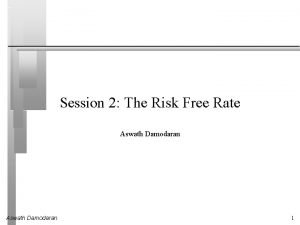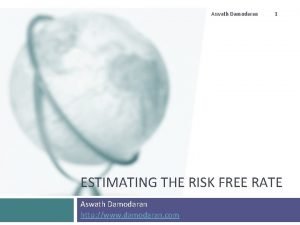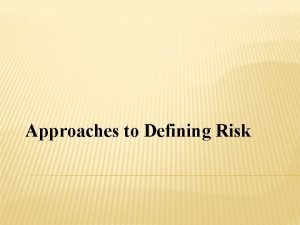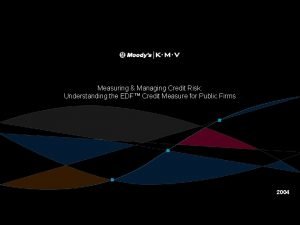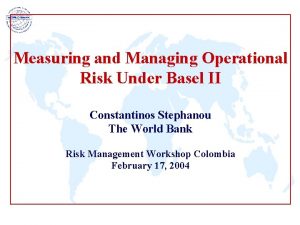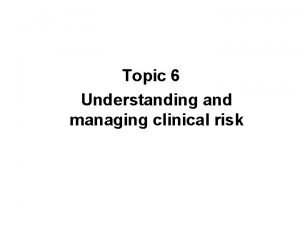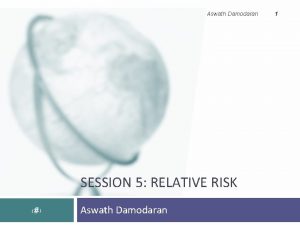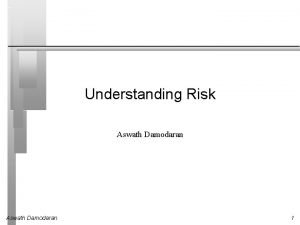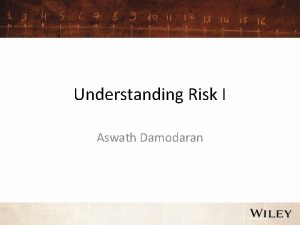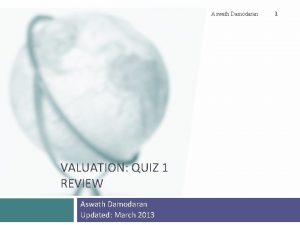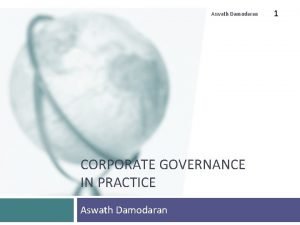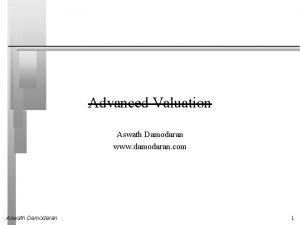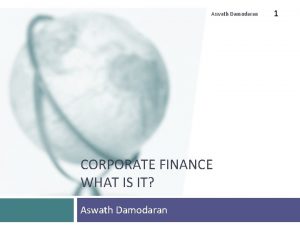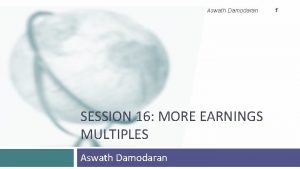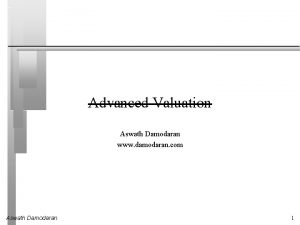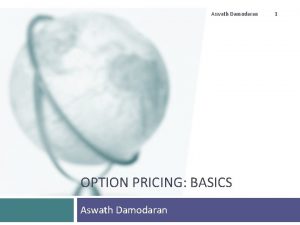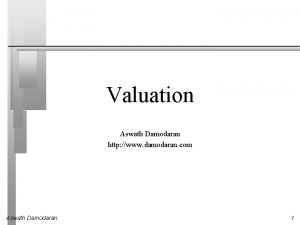UNDERSTANDING RISK I DEFINING AND MEASURING RISK Aswath













- Slides: 13

UNDERSTANDING RISK I: DEFINING AND MEASURING RISK Aswath Damodaran

What is risk? Risk, in traditional terms, is viewed as a ‘negative’. Webster’s dictionary, for instance, defines risk as “exposing to danger or hazard”. The Chinese symbols for risk, reproduced below, give a much better description of risk: 危機 The first symbol is the symbol for “danger”, while the second is the symbol for “opportunity”, making risk a mix of danger and opportunity. Put simply, the risk and return trade off on investing requires you to evaluate how much danger there is an investment and demand enough opportunity to compensate you for exposing yourself to danger. 2

Dimensions of Risk • Price risk versus cash flow risk: When you buy stocks, your risk can come from – – • • Variability in the stock price: Not only do you implicitly feel this risk (watching your holdings go up and down in value) but you are explicitly exposed, if you have to sell the stock. Variability in cash flows: In the strictest measure, this can be variability in dividends. More generally, it can reflect variability in the underlying earnings/cashflows. Total risk versus downside risk: You can measure risk as deviation from expectations in both directions(better & worse than expected) or just worse than expected. Stand alone risk versus portfolio risk: You can measure risk in a stock, as a stand-alone investment or as risk added to a portfolio of stocks. 3

The Risk/Return Starting Point Proposition 1: No risk, no return. If you don’t expose yourself to risk, you should not expect to earn a return higher than the risk free rate. � The Arbitrage Clause: If you can find a riskless investment on which you can earn more than the riskless rate, you have found an arbitrage position. Proposition 2: In an efficient market, your expected return will rise only if you expose yourself to more risk. There will be no free lunches. � The Beat the Market hope: If you can find inefficiencies, you may be able to exploit them to earn an expected return that is higher than what you should have given your risk exposure. 4

Measuring Price Risk The simplest measure of price risk is the volatility in the price, computed as a standard deviation or a variance. Since high priced assets will have higher price standard deviation than low priced assets, the volatility is usually standardized by looking at the returns on the asset. � The returns on an asset comes from price change during a period any cash flows that are paid on it. � They are in percentage terms and thus comparable across assets with different price levels. 5

A Single investment: Estimating the volatility in Disney Prices from 2008 -13 Disney: Stock Price and Returns (9/08 -9/13) $70. 00 0. 25 0. 2 $60. 00 0. 15 $50. 00 0. 1 0. 05 $40. 00 0 $30. 00 -0. 05 -0. 1 $20. 00 -0. 15 $10. 00 -0. 25 Se p 0 No 8 v 08 Ja n 0 M 9 ar -0 M 9 ay -0 9 Ju l-0 Se 9 p 0 No 9 v 09 Ja n 1 M 0 ar -1 M 0 ay -1 0 Ju l-1 Se 0 p 1 No 0 v 10 Ja n 1 M 1 ar -1 M 1 ay -1 1 Ju l-1 Se 1 p 1 No 1 v 11 Ja n 1 M 2 ar -1 M 2 ay -1 2 Ju l-1 Se 2 p 1 No 2 v 12 Ja n 1 M 3 ar -1 M 3 ay -1 3 Ju l-1 Se 3 p 13 $0. 00 Disney Stock Price Disney Stock Return 6

Across Asset Classes: US Stocks versus US Treasury Bonds Annual Returns on Stocks, T. Bonds and T. Bills - 1928 -2018 60. 00% 40. 00% 1928 1930 1932 1934 1936 1938 1940 1942 1944 1946 1948 1950 1952 1954 1956 1958 1960 1962 1964 1966 1968 1970 1972 1974 1976 1978 1980 1982 1984 1986 1988 1990 1992 1994 1996 1998 2000 2002 2004 2006 2008 2010 2012 2014 2016 2018 20. 00% -40. 00% -60. 00% S&P 500 (includes dividends) 3 -month T. Bill Return on 10 -year T. Bond 7

1. Downside versus Total Risk The standard deviation in returns or prices is based upon the deviation of either from the average and counts upside deviation (where you earn more than the average) as well as downside deviation (where you earn less than the average). To the extent that it is downside risk that creates pain, there are some who argue that risk should be measured looking at only negative outcomes. Semi variance measures the variance only in returns that fall below the average return. � A non-parametric measure of downside risk can be obtained by looking at the percentage of periods where a stock generates negative returns. With Disney, for instance, the returns were negative in 19 of 60 months. � 8

2. Cash Flow or Earnings based Risk Since most investment philosophies are built on the presumption that markets make mistakes, there are some who argue that it is contradictory to use a market number (prices, returns) to estimate the risk in an investment. In intrinsic value investing, in its purest form, you buy an asset for its cash flows and the risk to you, then, is the risk that these cash flows will not meet your expectations. For these investors, a better measure of risk may be the volatility in earnings or cash flows. 9

3. Stand alone versus Portfolio Risk When assessing the risk in an investment, you can look at risk in one of two ways: � Stand alone: You can look at the total risk in an investment. � Portfolio: You can look at the risk added by the investment to your portfolio. The Markowitz Revolution: If there is a change that has come to investments from the development of finance as a discipline, it is that rational investors should focus on the latter, not the former, since your wealth is determined by what your overall portfolio does. 10

The Intuition of Diversification On economic grounds, diversifying and holding a larger portfolio eliminates investment-specific risk for two reasonsa. b. Each investment is a much smaller percentage of the portfolio, muting the effect (positive or negative) on the overall portfolio. Investment-specific actions can be either positive or negative. In a large portfolio, it is argued, these effects will average out to zero. For every investment, where something bad happens, there will be some other investment, where something good happens. The latter benefit will occur only if your investments don’t move in proportion (i. e. , are perfectly correlated. Even if they move together most of the time, there will be diversification benefits from the times that they do not. The less your investments move together (the lower the correlation), the greater the benefits to diversification/. 11

The Statistics of Diversification The Magic of Diversification 45. 00% 40. 00% 35. 00% 30. 00% 25. 00% 20. 00% 15. 00% 10. 00% 5. 00% 0. 00% 1 2 3 4 5 6 7 8 9 10 11 12 13 14 15 16 17 18 19 20 21 22 23 24 25 26 27 28 29 30 31 32 33 34 35 36 37 38 39 40 41 42 43 44 45 46 47 48 49 50 Rho = 0. 2 Rho =0. 4 Rho =0. 6 Rho =0. 8 Rho =1 12

Risk: The Bottom Line We can disagree about how best to measure risk, but to argue that you do not have to measure risk or that risk does not matter is foolish. Different investment philosophies can come up with different measures of risk, reflecting different beliefs about markets and different time horizons. Every investor has to measure the returns that he or she generates on his investments against what he or she should have made, given risk exposure. 13
 Defining non defining relative clause
Defining non defining relative clause Relative clauses defining and non defining
Relative clauses defining and non defining Non defining relative clauses as sentence modifiers
Non defining relative clauses as sentence modifiers Defining and non defining relative clauses in telugu
Defining and non defining relative clauses in telugu Defining and non defining relative clause
Defining and non defining relative clause Relative clauses
Relative clauses Aswath damodaran risk free rate
Aswath damodaran risk free rate Cds damodaran
Cds damodaran Defination of risk
Defination of risk Market risk credit risk operational risk
Market risk credit risk operational risk Measuring and managing credit risk
Measuring and managing credit risk Basel ii event types
Basel ii event types Understanding and managing clinical risk
Understanding and managing clinical risk Www.damodaran
Www.damodaran






